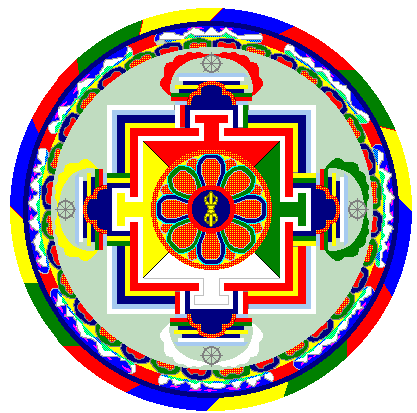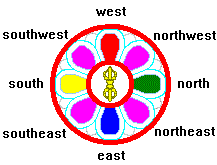 |
How to design your time |
Cat: HISPub: 1992#: 0614b |
Hiroaki Imaizumi |
06505u/18214r |
Title
How to design you time
時間をデザインする
Author
Hiroaki Imaizumi
今泉浩晃
Published
1992
1992年
Index
Why?
- Mandala:
Any of various ritualistic geometric designs symbolic of the universe,
used in Hinduism and Buddhism as an aid to meditation.
geometric designs symbolic of the universe,
used in Hinduism and Buddhism as an aid to meditation.
- Mandala is Sanskrit for circle, polygon, community, connection.
The Mandala is a symbol of man or woman in the world, a support
for the meditating person.
- 'MA' means mother or female in Indo-European. 'TARA' means eye
or pupil, and a name of boundary between this world and Pluto. TARA
also has meaning of to expand or diffuse, derived from 'STRI' of
Sanskrit. 'Terminus' of Latin means boundary, border or limit, and
etymology of Terminus of Roman God.
- Buddahs for meditation: North-Green (Air), East-Blue (Water),
South-Yellow (Earth), West-Red (Fire), and four female buddhas between
them.
- マンダラとは、
 ヒンズー教や仏教の儀式で使用される宇宙についての幾何学的なデザインである。
ヒンズー教や仏教の儀式で使用される宇宙についての幾何学的なデザインである。
- マンダラとは、サンスクリット語で円、多角形、コミュニティ、連結の意。マンダラはこの世の男女のシンボルであり、瞑想する人の救済となる。
- 語源:マンダラ=摩多羅の、マン=摩 (MA)とは印欧語で母親、女性)、タラ=多羅(TARA)とは、サンスクリット語では、眼、瞳。Taraとは冥界との境界神。拡大する、まき散らすの意もあり。サンスクリット語のStri
(Star)に由来。ラテン語のTerminusも境界、限界の意があり、ローマ神のテルミヌスの語源。
- 瞑想する仏陀:北=緑 (気) 、東=青 (水)、南=黄 (土)、西=赤 (火) およびその間の4人の女神
Summary
要約
>Top
0. Prologue:
-
What?
Where?
Who?
When?
Why?
This is a unique book of nonlinear thinking: a way of two-dimensional
thinking called 'Mandala art'.
- This described '5W mandala':
- X-axis: Where is a question in space, and when is
that in time. Who is a human being. Thus, X-axis represent
who (human), where (space) and when (time); so that it representsobjective axis.
- Y-axis: Who wants What, and why? Thus, Y-axis
representssubjective axis.
- This also means that you are surrounded by 4W: Where are you from
or going to? When did you come from, and when will you go? What
did you do, and what will you do? and Why did you do so, why will
you do so?
0.プロローグ:
- これは、非線形的な考え方、即ち、マンダラアートと呼ぶ二次元思考についてのユニークな本である。
- 5Wマンダラとは
- X軸は客体軸:
誰が(人間)、 どこで(空間)、いつ (時間)
- Y軸は主体軸:
誰が (人間) 、何を (目的) 、なぜ (理由) そうするのか
>Top
1. What is design?:
-
4)
Sketch
Drawing
3) Concept
Scenario
1)
Design
5) Device
Design
2)
Idea
Intent
Let's consider what is design in Mandala way: putting the word of
design as the center, and extend its meaning horizontally and vertically.
Then we can understand the process of design from 2) through 5)
as follows:
- 2) to have an idea or an intent.
- 3) to conceive a concept or scenario in the mind.
- 4) to make rough sketch or drawing in usually graphic form.
- 4) to create or execute an visible form in an artistic or skilled
manner.
1. デザインの意味
4)
下絵
素描
3)
構想
着想
筋書き
1)
デザイン
5)
意匠
図案
2)
計画
目的
意図
>Top 2. What is time?:
5) The world consists
of 5W's.
6) In conclusion, what is time?
7) The value of time is determined
by 5W's.
4) The answer
is not only one.
1)
Design time
8) The time is in your
mind.
3) Have more concrete image of time.ß
2) Imagine tempo of your living.
9) 5W's are what you do in your life.
5) Cycle:
rhythm
cadence
6) Hour:
period
deadline
time frame
7) Growth:
forecast
prediction
projection
4)
Procedure: sequence
process
steps
1)
What is time?
8) Change:
move
stir
activate
3) Age - epoch:
history,
trend,
ambience, atmosphere
2) Action:
experience,
life
9) Opportunity
chance
occasion
timing
2. 時間とは何か?:
5) 世の中は5W
6) 時間とは何か?
7) 時間の価値は5Wで決まる
4) 答えは一つではない
1)
時間のデザイン
8) 時間はあなたの中にある
3) 時間の過ごし方を具体化する
2) 時間の流れ方、生き方のテンポを考える
9) 人生でやることは5W
5) 周期:
リズム
サイクル
6) 時刻:
期限
機関
7)成長:
未来
予測
4) 手順:
プロセス
1)
時間とは何か?
8) 変化:
動く
動かす
3) 時代:
歴史
空気(雰囲気)
2) 行動:
体系
経験
人生
9) 機会:
チャンス
タイミング
>Top 3. What are you
doing now?:
What:
Your object
Your target
Where:
Your sequence,
human relationship
Who:
What
are you doing now?
When:
Your tempo
or rhythm
Why:
Why do you think so?
3. 今、何をしているか?:
What:
目標
狙い
Where:
連続
人間関係
Who:
今の動き
When:
動きのテンポやリズム
Why:
ものの考え方
>Top
4. Change your dimension:
What:
Change your action.
Change your method.
Where:
Change your space, or place.
Who:
Change
your party.
Change yourself.
When:
Change your time.
Change your occasion.
Why:
Change your sense of value.
Change your idea.
4.動かして変える:
What:
行為を変える
やり方を変える
Where:
空間を変える
場を変える
Who:
相手を変える
自分を変える
When:
時間を変える
時を変える
Why
価値観を変える
考えを変える
>Top 5. Can you move now?
Then you can start
to do it.
What:
Action is possible with consciousness
and environment.
But only one-time action produces
nothing.
Where:
Create an appropriate environment.
Who:
For
your action.
For your activation.
When:
Repetition.
Make it a habit.
Enlighten yourself.
Discover something.
Why:
Be conscious.
Generate your consciousness.
Such change produces another consciousness.
5.
すぐ動けるか:
初めて行動する
What:
行動化:
意識と環境が整って行動する
一度動いても何も生まれない
Where:
環境化:
環境を整えなければならない
Who:
行動するために
When:
習慣化:
やり続ける。習慣づけることで変化が生じる
意識づけとは啓発、発見すること
Why:
意識化:
まず意識することから始まる
その変化が新たな意識を生む
>Top 6. Memo for future
idea, and note for the past record:
- Memo or memorandum should be rough writing or sketching
of possibility, alternative or ideas for future action or decision-making.
- Note should be the liquidated description of the part
record, experience or discovery, which could be used for the future
reference.
- Therefore memo should be free-format, or have free space of
writing without of any priority like Mandala.
- Note should be sequential, or hierarchical and usually written
in liner order.
6.未来のためのメモ、過去の記録のためのノート:
- メモは、将来の行動や意志決定のためのラフな可能性やアイデアの記述であるべき。
- ノートは、過去の記録、経験、発見を整理した記述であるべきで、それはまた将来の参考として利用できる。
- それゆえメモは、マンダラのように優先度のない自由形式で書くことが重要
- ノートは連続的、あるいは階層的は通常は線形順序で記載される。
Comment
- >Top Human thinking should be multi-dimensional.
- It is true we have been trained or restricted to think according
to the order: priority, urgency, or instructions from the senior,
etc.
- Mandala way of thinking seems two-dimensional way of thinking.
- But actually why it is two-dimensional?
- 人間の思考は多次元的である。
- 今まである順序に従って思考することを教育あるいは強制されてきた。優先度、緊急性、上司からの指示など。
- マンダラ思考は二次元の思考法である。
- しかしなぜ二次元なのだろうか?
Title |
How to design you time |
時間をデザインする |
|---|---|---|
Author |
Hiroaki Imaizumi | 今泉浩晃 |
Published |
1992 |
1992年 |
Index |
||
Why? |
|
|
Summary |
要約 |
||||||||||||||||||||||||||||||||||||
>Top 0. Prologue:
|
0.プロローグ:
|
||||||||||||||||||||||||||||||||||||
>Top 1. What is design?:
|
1. デザインの意味
|
||||||||||||||||||||||||||||||||||||
>Top 2. What is time?:
|
2. 時間とは何か?:
|
||||||||||||||||||||||||||||||||||||
>Top 3. What are you doing now?:
|
3. 今、何をしているか?:
|
||||||||||||||||||||||||||||||||||||
>Top 4. Change your dimension:
|
4.動かして変える:
|
||||||||||||||||||||||||||||||||||||
>Top 5. Can you move now?
|
5. すぐ動けるか:
|
||||||||||||||||||||||||||||||||||||
>Top 6. Memo for future idea, and note for the past record:
|
6.未来のためのメモ、過去の記録のためのノート:
|
Comment |
|
|